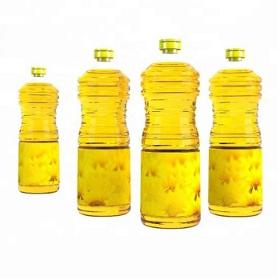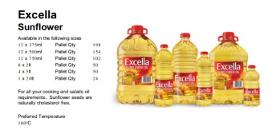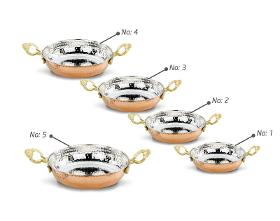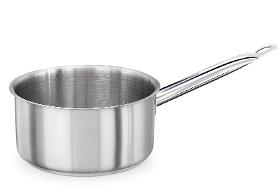- europages
- >
- COMPANIES - SUPPLIERS - SERVICE PROVIDERS
- >
- cooking equipment
Results for
Cooking equipment - Import export

HQ COSMETICS BV
Netherlands
Appearance: pure, refined, without sediments and with a light yellow color Taste and odor: Deodorized with good taste Saponification index 188,0 – 195,0 IRAM 5516 / ISO 3657 Unsaponificable matters Max. 0,7 % ISO3596 Acidity (80% oleic) Max. 0,07 % IRAM 5512 / ISO 660 Soap (ppm oleate of sodium) Max. 7ppm IRAM 5599 Index of peroxides (meq O2/Kg) Max. 4meg/kg IRAM 5551 / ISO 3960 Color: IRAM 5503 Yellow Lovibond (5¼”) Max. 12 ISO 15305 Red Lovibond (5¼”) Max. 1,2 ISO 15305 Moisture and volatile matters Max. 0,05 % ISO 662 Winter test Min. 24Hs IRAM 5595 Loss for heating (%p/p) Max. 0,05 % IRAM 5510 Phosphorus Max. 10ppm Citric acid 50 ppm
Request for a quote
DREAMCELSIUS GROUP AFRICA
South Africa
Sunflower seed oils are naturally cholesterol-free. Approved as part of the heart and stroke foundation eating plan. For all your cooking requirements. Sunflower seed oils are naturally cholesterol-free.
Request for a quote
DREAMCELSIUS GROUP AFRICA
South Africa
Sunflower seed oils are naturally cholesterol-free. Approved as part of the heart and stroke foundation eating plan. For all your cooking requirements. Sunflower seed oils are naturally cholesterol-free. Payments: Terms In order to avoid misunderstanding, at present we prefer to offer FOB/CIF price, because freight cost is unstable and constantly changes. We can discuss two types of SFO – crude & refined ones, and two types of ways of shipment: (MOQ, up to 6 000 mt per month) and CIF (flexi tanks, MOQ 200 mt, up to 6000 mt per month as well). Please note that we work on conditions of 100% prepayment. L/Cs are not acceptable on PET bottles. *All prices, available volumes, production time, logistic data and the rest information should be discussed before the order. ONLY BULK ORDERS WE ACCEPT NEW BUYERS PAY PARTIALLY OR FULL PREPAYMENT, THE WE CAN PASS TO LC/CAD.
Request for a quoteDo you sell or make similar products?
Sign up to europages and have your products listed

DE SMET ENGINEERS & CONTRACTORS
Belgium
De Smet Engineers & Contractors has been involved in all steps of the production of vegetable oils from oilseeds crushing for the construction of Edible Oils Plants; in this article you will find a more detailed understanding about the process of vegetable oil extraction: First step: Preparation of the oil containing material prior to solvent extraction Cleaning and Drying The plant feedstock must be cleaned so that foreign matters are removed. This applies particularly to sand/silicate and iron which may damage the preparation plant equipment. For some seeds or for some processes the incoming material moisture must be controlled and adjusted for better efficiency of subsequent operations. Mechanical preparation Most of raw materials needs to broken to reduce the particle size to ensure proper cooking and flaking. They are then heated in cooking / conditioning equipment and their moisture further controlled in addition to be softened before the next mechanical operations. After cooking, heated grits are flaked so that the oil cells are broken and the oil more readily available for further solvent extraction or mechanical pressing. Pressing Oilseeds containing above 20 to 25% (rapeseed, sunflower seeds, cottonseeds...) are generally pressed mechanically in order to extract most or part of the oil available in the feedstock. This operation is done through full pressing for maximum oil recovery leaving up to 5 to 10% in the final cake which is marketed as such or through a low pressure pre-pressing operation producing a cake with higher residual oil content which is then recovered in the solvent extraction plant. Dehulling Oil extraction plants produce a solid finished product in addition to the extracted oil; this product (cake or meal) is normally used as an important component for animal feed recipes. Depending on the meal destination, its protein content often needs to be increased and its fibre content minimized. Such characteristics are generally achieved through decortication or dehulling operations that separate the outer part of the feedstock before extracting the oil. Second step: Solvent extraction of the material suitably prepared Extraction In the solvent extractor, solids (Flakes from the flaking machines or cakes from the pre-presses) are conveyed through the equipment while a mixture of hexane and oil (miscella) is sprayed counter-current. The extractor produces therefore deoiled solids containing solvent and miscella. Desolventization Deoiled solids coming out of the extractor are conveyed to a dedicated equipment that completely removes the remaining solvent while preserving the meal quality: the desolventizer. This apparatus is usually combined with additional sections for drying and cooling the meal to the required storage and market parameters. Miscella distillation Solvent contained in the miscella is completely removed under vacuum and optimum temperature for preserving oil quality. The solvent from the distillation as well as the one removed at meal desolventization stage are then recycled to the extractor. Solvent recovery Since the air entering the process together with material fed to the extractor is laden with solvent when it is removed from the plant it first pass through a specially designed absorption column to limit emission to an acceptable level. Meal treatment The extracted meal is often subject for further treatment, including grinding to obtain the required granulometry or pelletizing to reduce its volume during transport.
Request for a quoteResults for
Cooking equipment - Import exportNumber of results
7 ProductsCountries
Company type

